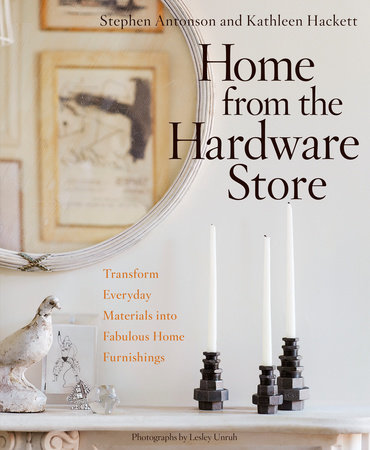Excerpt
Home from the Hardware Store
1
Seven Important Pieces
"Design addresses itself to the need," said Charles Eames, one half of one of the 20th century's foremost design duos. He and his wife, Ray, espoused a philosophy--good design at minimal cost with prefabricated parts--that we adopted as we surveyed the hardware store for the furniture ideas in this chapter. Whether we needed the pieces that follow or not, they compel us for the same reasons the Eameses turned plywood into their iconic lounge chair.
PEGBOARD + PINE STOCK = GRAPHIC PEDESTAL (see page 63) Pegboard's utilitarian quality has long been known to us, but its grid of dots is what drew us to this unexpected use--a sleek and minimalist pedestal appropriate for a cherished sculpture, your children's art, or a bust of Beethoven.
In the plumbing aisle, there is galvanized ductwork that when connected to form rings, stacked like doughnuts, and then topped with a round piece of pine makes a one-of-a-kind table. A pair of hollow-core doors, the bane of interior designers, covered with protective floor paper and embellished with thumbtacks becomes a folding screen that any David Hicks devotee would love. And then there are the steel supports in the shelving aisle. Bolted together, they make chic industrial frames for tables or chairs; plywood and pine boards supply the sitting and eating surfaces.
SAWHORSES + MDF + CANVAS DROP CLOTH = CHIC WORK TABLE (see page 66) "Only a #9 brass head will do," Dorothy Draper was fond of saying. With all due respect to the beloved mid-20th-century decorator, we used cut tacks here, inspired by Paris flea market canvases, which are always held to their stretchers with these.
The Eameses' "most of the best to the greatest number for the least" credo notwithstanding, our hope is that the pieces here inspire you to see common items--plumbing parts, pegboard, and luan doors--primarily as shapes, patterns, and textures. When you do, the possibility for original designs is endless.
CEMENT BOARD + FOUND FURNITURE = PARCHMENT-TOP TABLE (see page 76) To achieve the look and warmth of parchment, head over to the flooring aisle and stop in front of the cement board, a material typically used as a substrate for tiled floors or walls. Naked, it resembles a natural material; our first thought was limestone. With a coat of shellac, though, it becomes something else altogether.
KRAFT PAPER + LUAN BIFOLD DOORS = FABULOUS FOLDING SCREEN (see page 70) Inspired by a pair of leather upholstered doors designed by Jean-Michel Frank, the French designer known for his minimalist interiors, we saw potential in a roll of reinforced kraft paper (it protects floors during a renovation) and a bulk supply of thumbtacks.
SHELF SUPPORTS + WIDE PINE BOARDS = SNAP-TOGETHER FARM TABLE (see page 73) If you look at shelf supports as you would a child's Erector set, you'll see that they present as many design possibilities as the classic building toy. Bolted together into a rectangle, the L-shaped pieces form a rim for the pine board top to rest on. Their L shape also allows them to become legs that provide enough support to hold the whole thing up.
GALVANIZED ELBOWS + PAINTED TABLETOP = SPACE-AGE COFFEE TABLE (see page 78) If Marc Newson's Lockheed Lounge chair, which recently sold at auction for over $1 million, is out of reach, perhaps a few galvanized elbows will satisfy. Drawn to their arced shape, ribbed pattern, and shine, we found the tubes just begging to be stacked and attached, Michelin Man-style, into a perfect pedestal for a coffee table.
SHELF SUPPORTS + PLYWOOD = TWO-HOUR CHAIR (see page 82) It's child's play, really. If your attention span rivals the 8-and-under set, then there's nothing like a few strips of steel, some nuts and bolts, and a sheet of plywood to hook you into making this sculptural chair.




